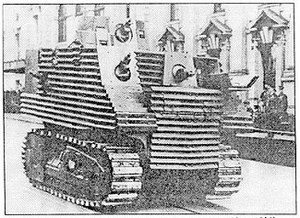Bob Semple tank
| Bob Semple tank | |
|---|---|

Bob Semple Tank in a parade on March 10, 1941 |
|
| General properties | |
| crew | 8th |
| length | 4.20 m |
| width | 3.30 m |
| height | 3.65 m |
| Dimensions | 25.4 t |
| Armor and armament | |
| Armor | 20.7 mm |
| Main armament | 4 MG Bren |
| Secondary armament | no |
| agility | |
| drive | 6-cylinder diesel 95 kW (126 PS) |
| Top speed | 24 km / h (road), 8–9 km / h (off-road) |
| Power / weight | 5 hp / t |
| Range | 160 km max. |
The Bob Semple tank was from the New Zealand Ministry of Works conceived and after his then Minister Bob Semple named tanks from the time of World War II . Since one had to make do with existing material, existing crawler tractors were supplemented with armor made of corrugated iron and steel plates. The vehicle, which was built without planning or drawings, had numerous design flaws and operational problems. It was never mass-produced and saw no combat use. Still, it became an icon for the New Zealand do-it-yourself mentality.
Design and construction
The idea behind the design was to build armored vehicles based on locally available materials and resources. It was decided that a caterpillar tractor was the right basis for this, since in the event of war an armored shell could be screwed onto the existing tractor within a short time, and the tanks would be ready for use quickly.
No construction drawings were made for the construction, an American postcard was used as a model, which showed the conversion of a tractor into a tank. Bob Semple and TG Beck, the department's engineer in charge of Christchurch, improvised. With the materials available to Bob Semple as Minister of Works, the prototypes were built in the department's workshops in Christchurch .
The end result was a 3.65 m high construction made of structural steel and corrugated iron made of manganese steel. It had a crew of eight and was armed with four Bren machine guns.
properties
The tank turned out to be a constructive failure. It was insufficiently armored, very heavy at 15 to 20 t, unstable and limited to low speeds due to the tractor gearbox. To change gear, the speed had to be greatly reduced or stopped. With only 5 HP / t, the vehicle was severely underpowered and extremely slow off-road at 8 to 9 km / h. In addition, the shape of the underlying tug and strong vibrations made shooting difficult and inaccurate. In combat use, the tall and slow vehicle would have been an easy target.
Whereabouts
During the acute threat of a Japanese invasion, the tanks were an effort to use civilian means to manufacture weapons for the defense of New Zealand. They were mainly used in parades in Christchurch, Auckland and other parts of the country. They were seen as a symbol of hope for New Zealanders.
“This tank was an honest attempt to do something with the available material when the attackers stood at the back door… instead of idly complaining, we felt it was our duty to make weapons with which our country and our fellow citizens could be defended. "
However, the tanks proved unsuitable and were rejected by the New Zealand Army. After the dismantling, they were used as tugs again.
swell
- ^ Tanks Encyclopedia. Retrieved December 28, 2018 .
- Rosslyn J. Noonan: By Design: A brief history of the Public Works Department Ministry of Works 1870-1970 1975, Crown Copyright p. 172 f.
- Jon Bridges, David Downs: No8 Wire: the best of Kiwi Ingenuity. Auckland, Hodder Moa Beckett 2000.
- Peter Cook: Defending New Zealand: ramparts on the sea 1840-1950s. Wellington, Defense of New Zealand Study Group 2000.
- Haimish Keith: New Zealand Yesterdays: a look at our recent past Sydney, Reader's Digest Services 1984.
